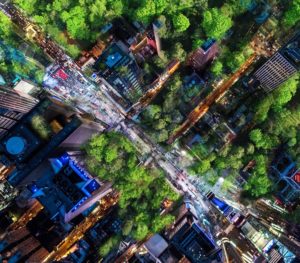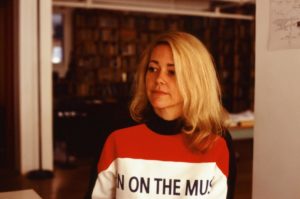
PROTOTYPE Festival 2021 Review: Times3 (Times x Times x Times)
An Experimental Walk Through New York City’s Most Iconic Place
By Jennifer PyronInnovation and extraordinary contemporary production which is vital to the continuation of opera-theatre and music-theatre works is at the core of this year’s annual PROTOTYPE Festival.
Both international and local new works presented online at this time give audience members across the globe a chance to experience multimedia and interdisciplinary art that challenges perspectives and invites audience members to listen with an open mind.
Composer Pamela Z and theatre artist Geoff Sobelle were approached last year by Jecca Berry, co-director of Prototype, and asked to create an accessible site-specific piece that invites listeners from anywhere to experience Times Square’s fundamental changes through sound. “Times3 (Times x Times x Times),” pronounced Times “cubed,” is a sonic experience created for now and the result of this proposal.
An Experiential Review
“Hello dear listener.
I invite you now to close your eyes
Wherever you are
And imagine yourself
Put yourself
Maybe you’re at home
Maybe you’re sitting someplace comfortable
You can close your eyes if you’d like
And imagine yourself in Times Square.”
I listened to Sobelle’s voice speaking this text along with Pamela Z singing beautiful bel canto riffs on my headphones as I stepped off the A train and onto the Penn Station platform. I had arrived at the underbelly of Times Square with “Times3” conveniently playing on my phone. I felt I was embarking on a familiar experience in a new way and in a new world, a walk through Times Square during the COVID-19 pandemic.
“Feel your feet on the floor
Maybe you’re outside
Take a deep breath in
Let your imagination scuttle down
Let your mind’s eye drift down, down, down
What happens if you let time just fall through your fingers
Maybe you are already there”
Once I made it through multiple confusing stairwells and escalators into Penn Station, I immediately looked for an exit. I felt relieved when I saw the sunlight peeking through a set of glass doors and took a deep breath through my surgical mask before opening one that led me outside.
I felt a strong pull of emotions when I waited at a crosswalk and saw for my first time an empty Broadway strip. The theater lights were dark. The crowds of excited tourists were gone. Times Square resembled a shell of its once overpacked and overwhelmed body of noise. Despite the uncomfortableness of its drastically different form, I felt grateful as I was able to now hear and enjoy “Times3” as I crossed the street and walked towards the center of the plaza.
I listened and observed myself as part of the sonic experience in that moment. I began to ask myself questions. How can I be in Times Square with a new perspective? What would this require of me? Why am I in Times Square? What do I intend to learn?
As I pondered these thoughts, the subtle nuances throughout the “Times3” composition pertaining to Mannahatta and the acquisition of land by the Europeans really caught my attention. I started to ask more specific questions inside of my mind about the land’s past turmoils and the present vibrational frequencies now locked into its core.
“The imperceptible moan of covered breathing,” said a female voice over my headphones. “Tickets. Tickets. Tickets…,” she continued.
I paused in this moment and acknowledged the absurdity of hearing this word when I realized I was standing by the closed red Tickets box office and looking at an empty Broadway theater strip.
“Tickets. Terror. Tickets. Terror…,” repeated the female voice.
Reflections
I reflected on the tension this made me feel as I tuned into a greater awareness around the history of Times Square. The multilayered composition of voices told stories, describing the topography of Mannahatta, and how others might have felt terror in the same place where I was standing in that moment.
As I critically listened to the compositional factors, I realized that “Times3” is a balanced combination of linear and nonlinear sound ideas that play off each other and drive the listening experience forward.
It is not a musical walk. It is a musical journey in the form of a think piece. Pamela Z combines spoken word, commercial sounds, natural sounds, and pieces of interview based stories that speak into Times Square’s historical context. She constructs interesting happenings around several central themes but most importantly she knows how to allow these ideas space enough to breathe and foster a life of their own together.
“Times3” is timeless.
After experiencing “Times3” in Times Square, I thought it a good idea to come back to my studio to further think on this piece and respond by writing a series of questions for consideration here:
What does it mean to listen more? What is listening awareness? Is listening awareness the beginning of listening intelligence? Are there certain sounds that increase intelligence while listening? If so, what sounds trigger the most immediate growth? If listening awareness became commonplace in an environment would the community develop a greater listening intelligence together? How so? What would this sound like?
I am also curious to specifically learn more about works by Adrienne Brown, Alan Weisman, Frank O’Hara, and Eric Sanderson. “Times3” has reinvigorated my curiosity at the level of listening and has re-established a deeper internal awareness of how we are all intrinsically connected.



